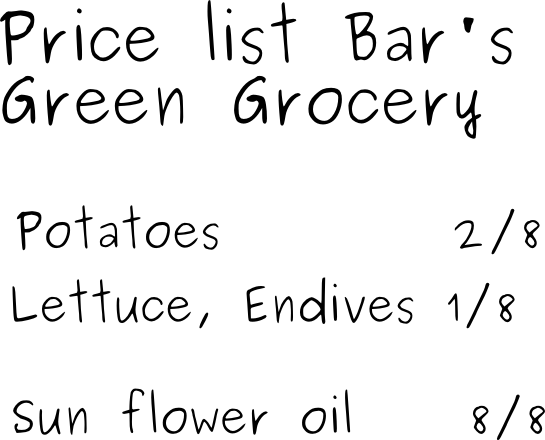At the shops
The easiest example is farmer's market, a shop that doesn't only sell but cultivated what they sell. Only the Red/Green ratio is indicated, because everybody understands that the cultivation is 100% organic and so there is no Blue. We don't even need a "per pound" indication either.
Potatoes 2/8 means that per 100 grams of potatoes 2/8 Red is asked. A kilo of potatoes is therefore 20/8 Red and 10 Green. We only reckon in eights, to make it as easy as possible. Also, there is no need to indicate the weight (as in 2 Euro/kilo) , because the weight and the Green value are 1/1, and you extrapolate the Red value from the ratio.
 This price list even less complicated than today's.
This price list even less complicated than today's.
A customer buys a given amount of products. In a note book the cashier makes the following calculations:
| Product | R/G Price | R | G | B |
|---|---|---|---|---|
| 5 kg Potatoes | 2/8 | 100/8 | 50 | 0 |
| 600 g Lettuce, Endives | 1/8 | 6/ 8 | 6 | 0 |
| 1 liter sun flower oil (1l = 1kg) | 8/8 | 80/8 | 10 | 0 |
| Totaal | 186/8 = 23 | 66 | 0 |
There are a few things that come to light in this price list. Let's take a look at the products. The potatoes contain almost the same amount as the oil. Remarkable because the potatoes are 5x as heavy. A look at the price explains a lot.
We continue the calculation in eights until the total. This reduces the margin of error, and it doesn't take that much extra effort. It's relatively easy to learn to divide by eight, because if you can't do it, just divide by two, again by two and again by two.
A lot of people try to add up the totals in RGB to each other: R 23 + G 66 = 89 RGB. That would really be handy, because it makes it easy to convert back to the Euro. But the question remains... Can you deduce the amount of energy and recyclables in 89 RGB? Try it!
Payment
Now we know the total, R 23 G 66 B 0, payment can be made in a number of ways. Keeping an "account" is the easiest when dealing with regular customers. The customer can sign off for their acquisitions. At the end of the month or week the shopkeeper enters all the data into an on-line payment system, and amounts are transferred from one account to another.
Another possibility is payment "in cash". Then you need printed paper money or coins. That's cumbersome, so we could use cheques. This cheque is also "cashed in" via the on- line payment system. This is handy if we're dealing with a "once-off" customer who doesn't have an account. In the chapter about money creation we will come back to this.
Playing shop is relatively easy. When we look at entire industries, it gets quite a bit more complicated. Soon have to deal with several products "that belong to each other" and the story gets very complex.